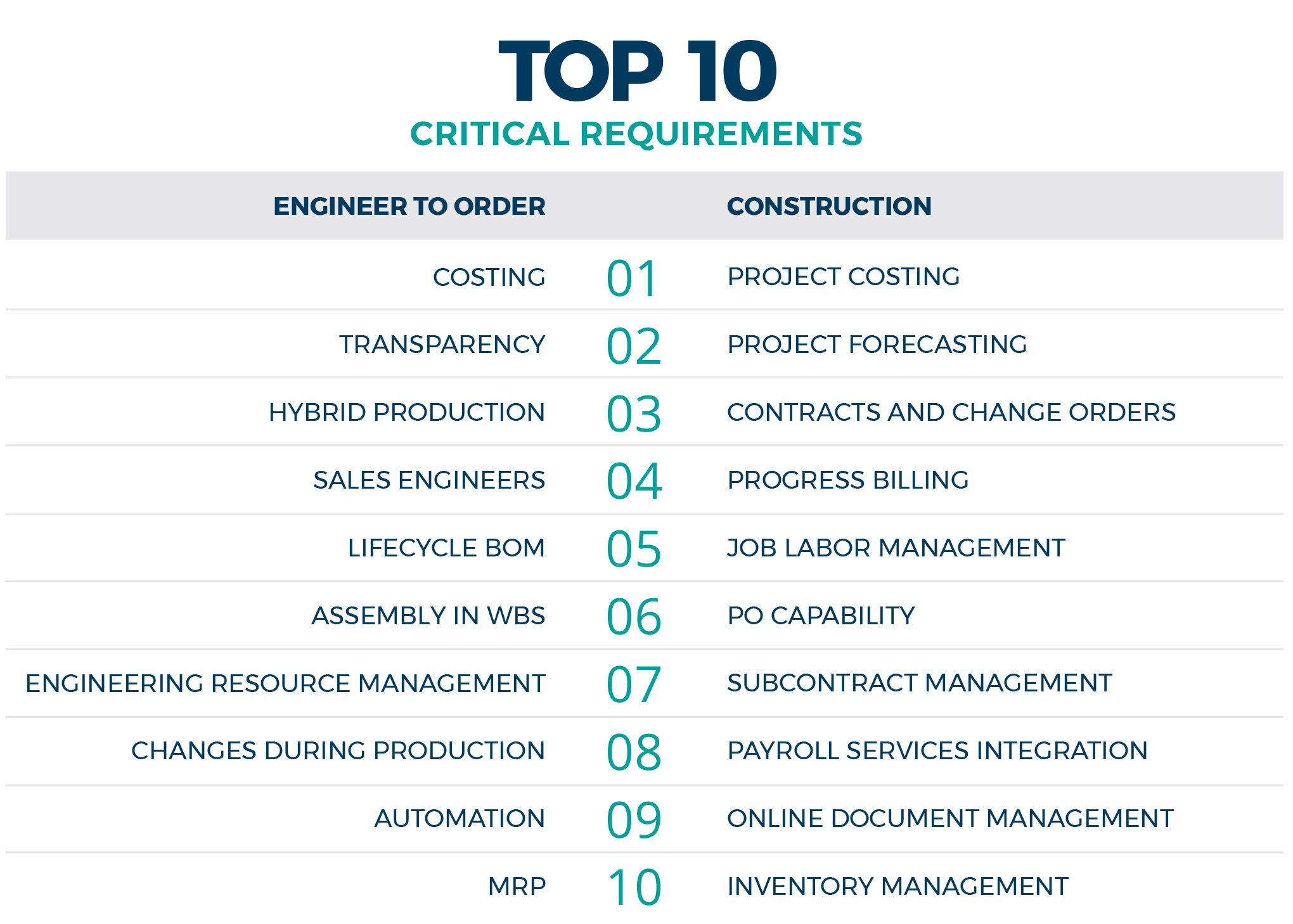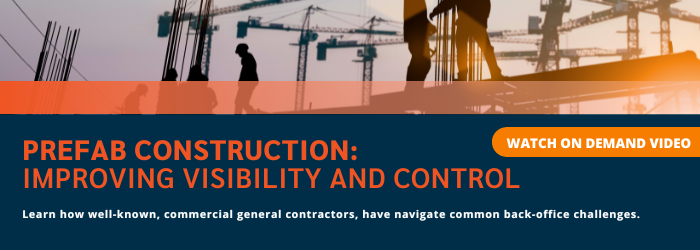This website uses cookies so that we can provide you with the best user experience possible. Cookie information is stored in your browser and performs functions such as recognising you when you return to our website and helping our team to understand which sections of the website you find most interesting and useful.
The Top 10 ERP Priorities in the Worlds of ETO and Construction

Construction companies that have transformed part of their business into ETO operations, as well as ETO manufacturers, look for certain functionalities with greater urgency than other capabilities.
Below, we highlight the 10 most critical requirements when it comes to ERP priorities for construction and ETO companies. Standard ERP systems can address some of these concerns to a degree, but not completely, and have wide gaps in other areas. Sikich HeadSTART for ETO provides coverage for all of these functional requirements.


Top 10 ETO Priorities for ERP
1. COSTING
For many ETO companies, costing is challenging and error-prone. They would always want to be able to understand the total costs of any project, including billable and non-billable time as well as manufacturing costs including raw materials, processing, and labor.
2. TRANSPARENCY
Many ETO businesses hope for better visibility across their operations. At any time, they want to have comprehensive, high-level views as well as the ability to delve into details in such areas as project performance, project costs against budgets, project profitability, subcontracting costs, vendor products and services, the time of engineers on presales and project tasks, and project schedules with their dependencies.
3. HYBRID PRODUCTION
Some ETO companies’ manufacturing operations combine features of project and discrete manufacturing. For projects, they require resource management and work breakdown structures (WBS), and for production they use BOMs and routings. They need to integrate these capabilities.
4. SALES ENGINEERS
Even if ETO companies use a product configurator to help customers choose features and options, the ERP system needs to provide for engineering team members to participate in every sales cycle to support the creation of reliable estimates. After the customer commits, these estimates in the system can turn into budgets that can be compared to actuals.
5. LIFECYCLE BOM
The system should allow ETO companies to translate a BOM, which represents the customer asset as manufactured and shipped, into a BOM that reflects maintenance actions throughout the lifecycle of the equipment.
6. ASSEMBLY IN WBS
Final assemblies and sub-assemblies need to be linked to WBS tasks.
7. ENGINEERING RESOURCE MANAGEMENT
The project management module should offer a way to manage and track as project resources the engineering skills on the team, the time engineers spend on presales and project tasks, and their availability and capacity.
8. CHANGES DURING PRODUCTION
ETO companies look for detailed tracking of product design, version, and BOM changes during the production process.
9. AUTOMATION
ETO firms hope to automate and simplify configure, price, quote (CPQ) workflows, proposals, routings, BOMs, and part number generation.
10. MRP
Companies require a comprehensive MRP solution to schedule and manage procurement and production once stakeholders have signed off on an engineering BOM.
Top 10 Construction Priorities for ERP
PROJECT COSTING with user-definable job tasks, jobs and sub-jobs, and support for complex job structures, with support for standard CSI codes and various cost categories.
PROJECT FORECASTING with job forecasting tools for such criteria as percent completion by task, estimated cost amount per task, estimate to complete, estimate at complete.
CONTRACTS AND CHANGE ORDERS for owners, general contractors, architects, and engineers, with flexible, billable line items.
PROGRESS BILLING based on percentages, units complete, schedule of values, and other contractual provisions.
JOB LABOR MANAGEMENT with burdened labor rates, wages and benefits, and time entry support.
PAYROLL SERVICE INTEGRATION to simplify finance and payroll management while ensuring accuracy of job costs.
INVENTORY MANAGEMENT based on job requisitions and inventory calculations against job planning dates.
PURCHASE ORDER CAPABILITY for vendors and subcontractors with project-committed costs and options for purchase quotes, blanket orders, and purchase order processes for single and multiple jobs.
SUBCONTRACT MANAGEMENT for budgeted job items, attachable to subcontractor cards and vendors, with functionality for lien release tracking, lien release waivers, change orders, and certificates of insurance.
ONLINE DOCUMENT MANAGEMENT for convenient, anytime review, editing, sharing, and approvals of project documentation and contracts.
Want to dive a little deeper into these top ERP priorities for ETO manufacturers and construction companies? Please check out our free ebook, Building a Best-Fit Technology Platform for Offsite Construction.
This publication contains general information only and Sikich is not, by means of this publication, rendering accounting, business, financial, investment, legal, tax, or any other professional advice or services. This publication is not a substitute for such professional advice or services, nor should you use it as a basis for any decision, action or omission that may affect you or your business. Before making any decision, taking any action or omitting an action that may affect you or your business, you should consult a qualified professional advisor. In addition, this publication may contain certain content generated by an artificial intelligence (AI) language model. You acknowledge that Sikich shall not be responsible for any loss sustained by you or any person who relies on this publication.




